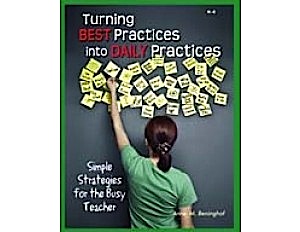Turning Best Practices into Daily Practices: Simple Strategies
Turning Best Practices into Daily Practices: Simple Strategies for the Busy Teacher
By Anne M. Beninghof
(Crystal Springs Books, 2010 – Learn more)
Sometimes I feel like a carpenter, electrician or plumber. I reach into my teacher toolkit and pull out the best tools to get the job done. Anne M. Beninghof’s book, Turning Best Practices into Daily Practices: Simple Strategies for the Busy Teacher, is a must-have toolkit for the novice or the experienced teacher. She provides easy, research-based strategies that can be used with any subject or grade level. Ms. Beninghof, author of Engage All Students and numerous other books, is a consultant and educator with over 30 years of experience in the field of education.

I also knew from my own research and teaching that best practices are based on educational research and inherently develop thinking and problem solving skills through active learning. They are the building blocks that stimulate students’ learning and achievement. I knew this so I thought I knew it all!
However, as I continued to read Ms. Beninghhof’s book, a quote from the beginning pages kept resonating in my mind. “To effectively lead students on the learning pathway, teachers must first grab attention. If none is paid, the subsequent milestones in planning memory will never be reached. No attention?- no activity. No activity? –no learning.” (Jones, 2003).
Substantive, exciting ideas about teaching
Beninghhof’s book isn’t an encyclopedia of time filler activities but a book that will soon be marred by dog-eared pages. The owners of the book will have to put a tracking device on it to make sure that the book is returned to them – quickly. This is a book that engages teachers to be active learners and to reflect on their own teaching as they review strategies and apply them. Each lesson is research based and contains reflective questions to help teachers hone the strategy into their own.
Some of the activities may be ones we’ve used in the past but filed them in the back of our teacher toolbox, forgetting the folder they were stored in. If so, we’ll be excited to discover them again!
One of the activities that Beninghof provides is the Concept Continuum. “Concept Continuum provides students with a collaborative group process of analyzing the similarities and differences in word meaning by sorting words along a continuum.” Students work in groups to discuss the order of the words by looking at the similarities and differences and lining the words along an imaginary continuum. For example, the words small, tiny, minute, mini, little, insignificant and microscopic might be look like one of the following:
microscopic, insignificant, minute, tiny, mini, little, small, modest or microscopic, minute, insignificant, tiny , mini, small, little, modest
I’m always looking for novel ways to assess my students daily. Teachers can use the Passing Time Strategy as an entrance or exit slip in any subject area—at any time! What a nifty way to find out if students understand and get them to think creatively at the same time. Several cross-content challenge questions are:
- If you had to create a CD about this lesson, what would the album and song titles be?
- If the principal were to walk in right now, what 5 words would you use to explain to him or her what you were learning about?
- How would you explain the importance of this lesson to the President of the United States? If you could place something from this lesson in a time capsule, what would it be and why?
- How would life be different if this concept didn’t exist?
These are just a sampling of the great ideas that you will find in the book. If you are a busy teacher and your district wants you to use research based activities to reinforce learning, you will appreciate the fact that the author has already done the research for you. If you want to liven up your teaching, this book is for you. If you want to bring fresh ideas into your classroom, this book is for you.
Beninghof’s strategies are rich examples of how to increase participation, help students focus their attention, and strengthen memory and retention. Open the book and you will find ideas that will have your children asking, “Can we do that activity again?”
Linda Biondi is a fourth grade teacher at Pond Road Middle School in Robbinsville, NJ, and a recipient of several educational grants that infuse a literacy enriched curriculum with an understanding of individual learning styles to help students understand bias and patterns of discrimination. She is a Teacher Consultant with the National Writing Project and a participant on the NJ Department of Education Teacher Advisory Panel.































